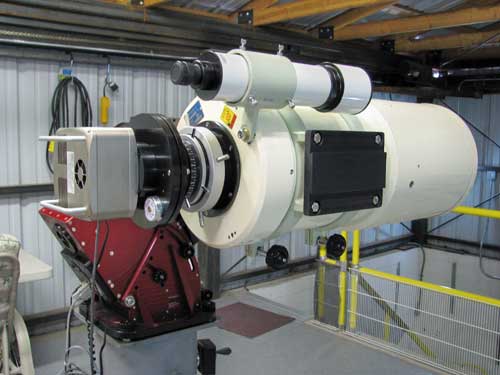
The Bunker Ranch Observatory has a high-quality photographic instrument in the Takahashi BRC-250; this is a Ritchey-Chretien telescope with a two-element Baker corrective lens, by Takahashi of Japan. An R-C is one of the family of Cassegrain two-mirror optical systems in which the secondary mirror reflects the light through a hole in the center of the primary mirror, forming an image behind the primary. The BRC-250 is pictured with the Finger Lakes Instrumentation (FLI) PDF computer-controlled focuser and a Santa Barbara Instrument Group (SBIG) STL-11000XM CCD camera, riding on a Software Bisque Paramount ME™.
(Photo by Stephanie M. Friedrichsen)
The Ritchey-Chretien design uses a hyperbolic primary and a hyperbolic secondary to produce images in which the stars are round across the entire field; this makes it very suitable for photography. The main aberration is that the star image dots are larger as one moves away from the center of the image; this is corrected by a lens system (a Baker corrector) that is placed in the central hole of the primary mirror. Hence the "BRC" in the name of the telescope; it is a Baker-corrected Ritchey-Chretien.
The fast f/5 focal ratio of the BRC-250 helps to shorten exposure times when acquiring images, and the shorter focal length also yields a wider field of view. The primary mirror is 260mm (10.2"), and the instrument has an effective aperture of 250mm (9.8") with a focal length of 1268mm (49.9").
The tube is made of carbon fiber, which has a near-zero coefficient of thermal expansion; thus the telescope holds its focus even through the wide temperature swings of the high desert. One benefit of this is that long time exposures do not need to be suspended for refocusing as the temperature plummets at night. Unfortunately, Takahashi no longer makes this instrument with carbon fiber; the aluminum-tube model is equipped with a temperature-compensating secondary holder, though.
Many instruments of this type are focused by moving the secondary mirror toward or away from the primary mirror; this allows for a very wide range of focal positions behind the primary. However, it does also induce some (very slight) aberration, because the primary and secondary mirror curves are optimized for a single fixed spacing. The BRC-250 instead focuses in a more traditional way, with a moving helical focuser tube behind the primary.
This instrument is similar in appearance to the popular Schmidt-Cassegrain telescopes made by manufacturers such as Meade® and Celestron®. However, the BRC-250 does not have a corrector plate at the upper end of the tube, and does not focus by moving the main mirror. The lack of a corrector plate means that the telescope cools down to ambient temperature much more quickly at night, since the tube is open rather than closed; such a corrector plate is also susceptible to dewing. Moving the main mirror is a poor way to focus for astrophotographic purposes; the mechanism allows slight movements of the mirror as the scope tracks the sky, ruining long-exposure photographs.
Terry R. Friedrichsen
terry@mail.trf.sunquest.com